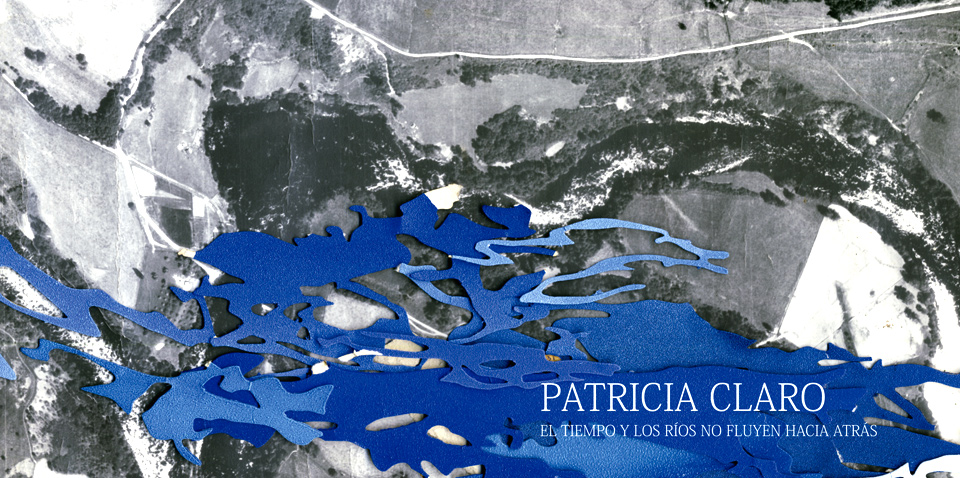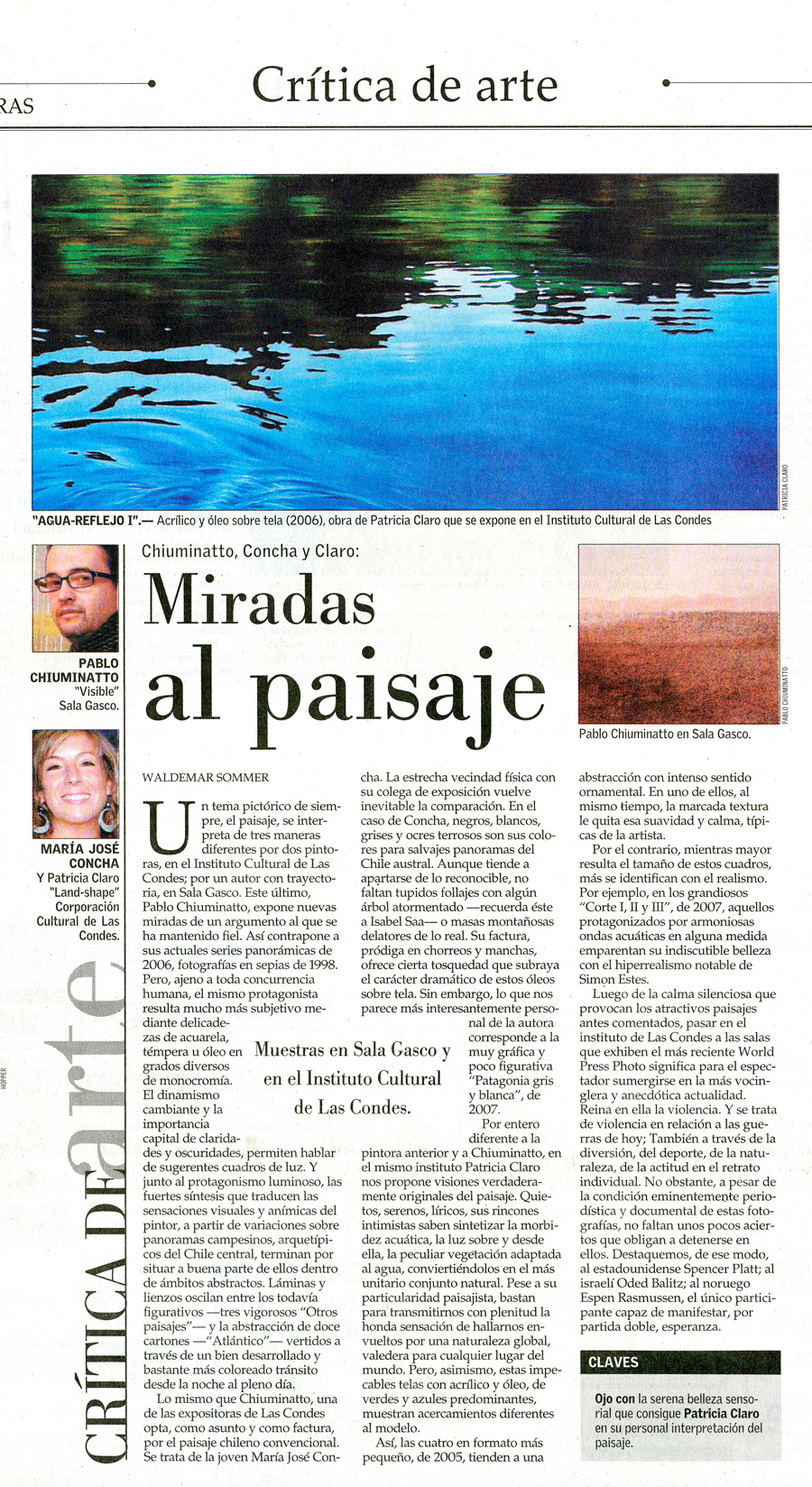María Olga Giménez. Bachelor in Arts and Literature.

Time and rivers don’t flow back is the title of Patricia Claro’s second solo exhibition at Animal Gallery. This collection is the fruit of a study about water and it’s characteristics where rigorous observation of reality has given the artist more insight about the natural laws that determine the particular properties of this element.
In conjunction with the aforesaid, the artist conducts a study on the concept of time, in which she explores the internal mechanism that allows water to flow permanently. The video is a complement to the pictorial representation and a synthesis of this study. It demonstrates a variation of light intensity throughout the day, revealing a series of changes that water experiences in its natural setting. The sequence of images uninterruptedly delivered by the river evokes the idea of infinity, as water continues to reflect and mirror, going beyond the limits of the framing and temporality of the chosen captions. This temporality (which represents a non-existing instant at present time), contrasts with the idea of the eternal flow of water and is the substratum of the author’s reflexion with respect to time. The artist’s strategy starts from filming from a fixed angle that is manipulated through flipping, direction change and synchronized clips, among others. The objective is to recreate the presence of the river in the most vivid possible way. The video is a mise en scene of the river as the origin of the paintings.
The idea of time present in the videos as well as in the pictorial sequence connects with the theory of Heraclitus where movement is considered as the characteristic phenomenon of all that exists. The famous saying “no one bathes twice in the same river, extracted from the work of this pre-Socratic philosopher, alludes to the changing condition of all reality, starting from anything defined in a particular space and time, and mutating in accordance to the changing process of both factors. Heraclitus uses the image of a river to represent the temporary nature of reality, the river being the best proof to the passing of time and the singleness of every lived instant. This paradigm supports the title of the exhibition. The evanescence of the mirrored images in the water with its unique and unrepeatable character grants a sort of sacredness to the piece of river chosen by the artist, for one is facing a scene that only occurs in that time-space and exists only once. Finally it is the river that determines and dictates the images appearing in the paintings.
The collection is a sequence of images of the same portion of water. The images are only fractions of a minute away from each other, thus giving continuance to the presentation. The span of the sequence encloses only 8 seconds, enough time for a wave to expand and disappear. A variation in the intensity of light is added to this representation of movement in water, simulating sunlight throughout the day, and revealing the transparency of water and its ability to mirror all that surrounds it.
This work is made possible due to the interrelation between nature and technique as part of Claro’s internal creative process. The predictable- represented by the digital caption- converges with the unpredictable and random- the water in its natural setting-, forming a triad: nature-technique-painting. The use of contemporary technology points out to the presence of a versatile studio, where thoroughness and deliberation of manual work intertwines with efficacy and arbitrariness of the technique, building a system that defines her particular style.
To fully understand the creation of the artist, one has to go back to the setting where the work originated. Instant photography is the result of a detailed and accurate monitoring of every transformation process that happens in nature, where the artist is witness to water cycles as seasons change. This constant rigorous observation shows the author’s personal adaptation to the rhythm of the river as the source of her images as she is subject to its changes in order to make an accurate representation of reality. Being a witness to the process of change in water according to its particular time and adjusting to it, year after year, is a testimony of the nobility of her creative process. It resembles the selflessness and generosity of water reflecting everything around it.
The adaptation of the artist to different rhythms and cycles of nature grants her style a kind of uniqueness marked by the presence of different times throughout the process. The first time corresponds to nature itself, the stage from which the image is captured to be used as the basis of the pictorial image. With the second time a creating process begins, where the rhythm depends on the quality of the material used and the sophistication of the techniques used by the artist to approach figuration by cutting. Both times imply the artist’s diligence, calmness, and submission. This patient attitude which corresponds to her personal rhythm joins nature’s (rhythm) in order to capture and represent each image. The rhythms of water cannot be intervened; neither can the rhythm of painting and the creative process.
The artist’s patient attitude throughout the process resembles the internal disposition suggested in Tao Teh King or the Taoist book of wisdom. The book states that contemplating nature is one of the ways which leads to the path of knowledge.
According to this, it is possible to establish certain links between Claro’s style and the oriental principles of aesthetics. One of them is the way she deals with her object of study as she implies a depersonalization in order to assimilate and internalize the timing of nature. It is the only possible way for her to inspect and perceive the particular characteristics of water: it’s lack of identity, it’s formlessness, it’s lack of color and it’s transparency; identifying it as a “sounding solitude”[2].
“By not being we can contemplate on the essence. By being, we only see
the appearance.”[3]
This quote from the Taoist text draws allusion to the existing opposition between movement and stillness. It expresses that contemplation of reality is possible by not-being while only seeing the appearance is product of being. The message of the Taoist book is a description of a way of life that allows contemplation of reality and therefore guaranteeing the knowing of truth. The essence of reality is identified with Tao, which contains as well as sustains all that exist in the world we perceive. It is Tao’s embodying characteristic that makes it similar to water with its ability to contain the landscape- from the sky to the earth- , and at the same time mirroring it with fidelity and detachment (As shown in the paintings of the artist). This feature of water is present in Patricia Claro’s work, whence it is possible to understand the idea of Taoist emptiness.
“The highest goodness, water-like,
Does good to everything and goes
Unmurmuring to places men despise;
But so, is close in nature to the Tao”[4]
The identification between Tao and the concept of emptiness leads to a search about the dialectic between water and the environment, where the image is a product of the reflection of light waves that bounce from the exterior surface. Water needs the tree to be seen because it cannot do so all by itself.
Understanding and studying the emptiness as well as differentiating its common meaning from the Taoist acceptation of the term, has been a substantial support in the development of the artist’s creative journey, particularly in its conceptual aspect and theoretical framework. To perceive water as an absence which is also infinite and undefined presence of new images has allowed her to use the concept of emptiness as a strategy to conceive the work.
Another point where the aesthetics of the artist and the oriental meet is evident in the use of paper-cutting for the construction of light filters which is an ancient technique in China dating back to 200 B.C. It consisted of using small scissors and chisels to cut paper. The final work was hung from the windows to filter the light entering. There is a drawing technique that is called “paper cutting” or “ Jianzhi”. This technique is referred to the way Claro proceeds with the drawing, as she creates the effect of light in the painting through a light-defining cut resembling a “chiseled mask”. The cutting of paper-done with laser technology, grades the intensity of light over the surface. This “handmade” light gives the image dynamism, as it creates a sense of movement similar to the waves produced by the currents. Every piece without a mask is a window that lets in beams and photons transformed into pictorial material. They define the image and give rise to the distorted reflections of the surrounding, which in turn reveals what there is in the exterior.
It’s essential to point out that Claro’s study about the quality of water is related to the biodynamic research done by Rudolph Steiner. The study focuses on water, as a living organism, and its characteristics in relation to the environment and the system it is part of. As the artist’s work of demonstrates the behavior of water in response to certain climatic, geographic and seasonal conditions, among other factors, it places it amongst hydrographic works of the planet and its ecosystem. Water chosen by the artist-as the basis of her work- is part of only 1% of the entire world’s water (the percentage of Sweetwater which is not frozen as glaciers, nor is groundwater)[5]. Therefore it is a rescue mission to do a study focused on the fugacity of time and its relationship to the water’s mirroring images. It draws the attention of the spectator in an attempt to change his view about this portion of water in extinction and its particular beauty.
1. El título de la exposición está inspirado en la novela de Yasunari Kawabata titulada Lo Bello y lo Triste. Emecé editores, Buenos Aires. 8va ed. P. 119.
2. Luis Racionero, Textos de Estética Taoísta. Editorial Alianza: Madrid, 1999. P. 52.
3. Lao Tse, Tao Teh King. Editorial Sirio: Buenos Aires, 2004. P. 11.
4. Ibid. P. 25
5. Fuente: National Academy of Sciences. Washington, DC. September 2011.


